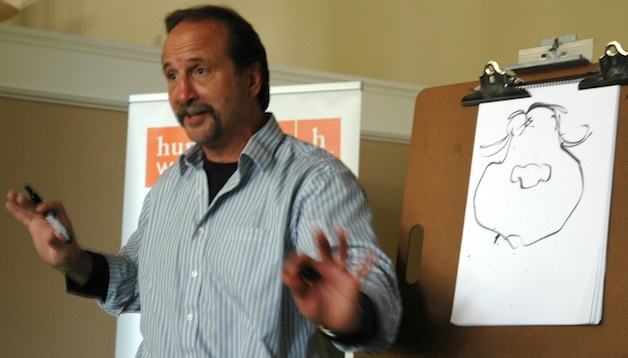MARYSVILLE — “I draw cartoons that piss people off,” said Milt Priggee, whose career as an editorial cartoonist began in 1976 and included several years at The Spokesman-Review in Spokane.
Priggee stopped by the Windsor Square Retirement Community Feb. 20 not only to show his work, but also to offer a short history of editorial cartooning, as well as a look at its future.
Priggee noted that he’s been sued for libel three times for his cartoons, but he’s never lost in court. Indeed, one of the biggest changes he’s seen in his profession is that newspapers used to court controversy through their editorial cartoons, whereas now, he sees them shying away from it.
“My editors used to ask me if I could get readers incensed enough that their phones would start ringing off the hook,” said Priggee, who noted that The Spokesman-Review used to sell bumper stickers that read “I (Heart) Priggee” and the opposite, to try and create buzz in the community. “Now, though, they’ll beg me not to draw anything that might make their phones ring.”
Priggee noted that cave-painted pictures predate the written word by thousands of years.
“Editorial cartoonists, we’re visual shock-jocks, looking to get your attention,” said Priggee, citing examples from the American revolution, including Benjamin Franklin’s “Join or Die” flag, depicting each of the colonies as a separate segment of a snake, and Paul Revere’s gory depiction of the Boston Massacre. “Seeing all that blood makes it real that people are being killed.”
Priggee pointed out that memetic editorial cartoons have earned the public’s affection as well as its scorn. While Thomas Nast turned Boss Tweed, the leader of the Democratic Party machine at Tammany Hall, into a popular villain, his cartoons also gave Santa Claus his familiar pipe and plump belly.
“When Teddy Roosevelt was out on safari, they brought out this bear cub for him to shoot and he refused to do it,” Priggee said. “Jim Berryman heard about this, and thought it was such a great story that he drew it. From then on, whenever he drew Teddy Rosevelt, he always put that bear cub by his side.”
A toy manufacturer would go on to make dolls of the cub, which they named “the Teddy bear.”
The first editorial cartoon Priggee understood as a child was an illustration of Abraham Lincoln crying in 1963, in the wake of John F. Kennedy’s assassination.
“There were no words, but I immediately got why this was why we weren’t going to school that day,” Priggee said. “Words inform us, but pictures move us emotionally.”
Priggee recalled that, in the years before newspapers had the technology to reprint photographs, their cartoons were typically placed on their front pages, as their primary selling points.
“Each newspaper was preaching to its own choir,” Priggee said. “They all had their own political viewpoints.”
As newspapers became more profit-conscious, they switched from each employing their own foreign correspondents to all drawing from the same overseas reporters, which would become the Associated Press, which sold their stories to all the papers by sticking to the facts, without an editorial slant.
“Before, the whole newspaper was an editorial,” Priggee said. “But once that got reduced to an editorial page, it took the cartoonist with it, off the front page.”
By contrast to the rest of the news pages, Priggee takes it as a given that “I can’t please anybody, and if I try, I won’t please anybody.”
When asked where he gets his ideas, he defers credit in a tongue-in-cheek manner, claiming that “I have the best humor writers in the world; Trump, Cruz, Clinton … my job is to march down the hill, after the battle, and shoot the wounded.”
Priggee makes no apologies for his biases, and has even seen some of his cartoons pulled because of how strongly he’s raised objections to other points of view, including cartoons he’s seen online.
“The Internet is like the Wild West,” said Priggee, who maintains his own online presence. “Gutenberg had a good run, but the Internet is where it’s all going, and there’s some ugly stuff out there.”
Priggee showed a number of racist depictions of President Obama that he’d found online, portraying him as a primitive tribesman and referring to him by the N-word, so when Obama won re-election, Priggee expressed his feelings about those racists with a scorecard that simply read, “[N-word] 2, Racists 0.”
“I can draw anything I want, but the flip side is they can reject it for any reason they like,” Priggee said. “A bad cartoon is one that takes no position at all.”


